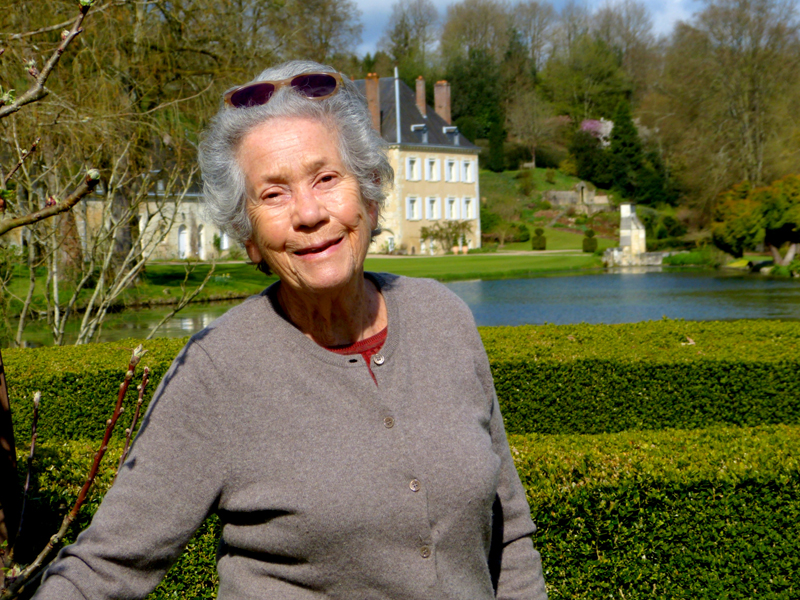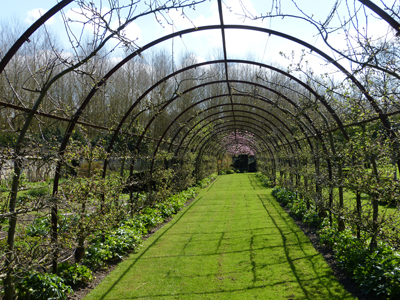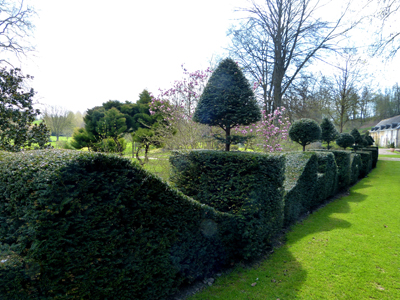Jardin du Plessis
This item appears on page 53 of the February 2016 issue.
In the spring of 2015, I lived for six weeks in the Loire Valley town of Blois. My primary reason for being there was to improve my French via self-imposed immersion. In doing so, I sallied forth beyond the well-trod châteaux route in search of unique gardens of the Loire. Four articles resulted. The first was on Chédigny, a tiny village designated in its entirety a Jardin Remarquable (Oct. ’15, pg. 55). The second featured Château du Clos Lucé (Dec. ’15, pg. 49) and described a garden with deep roots to Leonardo da Vinci. Here is the third. — YMH
Madame Rosamée Henrion and I paused in our stroll along the aptly named Magnolia Walk to take in an overview of her garden, the Jardin du Plessis. Centered around a lake, the garden fills a small valley of approximately four acres, part of a larger estate in her family’s ownership since the 15th century. In 1960, Madame Henrion inherited the property.
It was a blue-sky morning in early April 2015. The garden, Madame Henrion explained, would not evolve into full glory until the calendar flipped forward several weeks. Under-plantings of fragrant plants beneath the magnolias along our walk were yet to come. As were the roses and the flower gardens organized by color — yellow and white, pink and blue, deep shades of purple.
“Later in the season there is fragrance and color at every turn,” she commented.
Nevertheless, the garden was quite glorious to my eyes, with a small stream and waterfall tumbling into the lake, and spring-flowering shrubs and trees in full blossom-billowing splendor.
“It’s not quite an English garden but not quite a French one either.” Madame Henrion pointed out the clipped yew hedges punctuated with topiary that organizes spaces as typically French and the sweeps of lawn and the free-form planting of shrubbery and trees as English.
“I borrowed whatever pleased me from each,” she said, crediting visits to Highgrove, the royal gardens nurtured by the Prince of Wales since the 1980s, as her greatest source of English landscaping inspiration.
As we walked along, Madame Henrion described the property at the time of her inheritance — “All but abandoned since 1914. The house and outbuildings in disrepair, the entire valley strangled in overgrowth.”
Restoration came about bit by bit, with the Henrion family, which included four boys, coming down from Paris for country getaway weekends.
Today, it is hard to visualize the property in disrepair, its centerpiece lake surrounded by immaculate lawns and gardens, its neat lineup of restored structures nestled against the edging hillside.
Stone steps delivered us into the heart of the garden. Along the way, at the top of the waterfall, we stopped to admire the giant-leafed Gunnera, a Brazilian native, flourishing in one of the valley’s many microclimatic niches Madame Henrion discovered via plant trial and error through the years.
“And here, Actinidia melanandra, very rare.” Madame identified a vine clambering up the exterior of an outbuilding as we passed by, a plant introduced to England’s botanical world in 1910 by famous plant hunter Ernest Wilson from a collection expedition to China.”
“Plants stay in the garden only if they are happy,” she said. “I don’t have time to put a scarf on them in winter, a sunhat in summer.”
Its place in the community
Although the outside world seemed far away as we strolled toward the far end of the garden, a church spire glimpsed through the trees made it known that the tiny village of Sasnières was right next door. In 1995, Madame Henrion was named mayor of Sasnières, a position far less demanding than that taken on by her brother-in-law, Valéry Giscard d’Estaing, who served as French president for the years 1974 to 1981.
One of the first items to come before the council she headed was an approval request by a Sasnières property owner to open his garden for touring one day a year. The council voted ‘Yes,’ while Madame Henrion thought to herself, ‘My garden is every bit as beautiful and interesting as his. Why not request to open mine one day a year?’
Through the years, Jardin du Plessis’ “one day a year” multiplied to today’s five days a week, April to November.
With the 1996 public opening, Madame Henrion accelerated her gardening efforts. Each season offered expansion and new beds of color. In 2004, her garden was officially named a Jardin Remarquable, a designation created by the Ministry of Culture in 2003 to officially recognize France’s most magnificent gardens.
Memorable visit
Following the perimeter of the lake, we stopped to meet the dogs as we made our way toward “an idea directly stolen from Highgrove,” a long alleé of espaliered apple trees, with varieties chosen to ensure a parade of spring blossoms.
Circling back, there was a snake-bark maple and a peeling maple to admire (“chosen for their interesting bark”) and a stone archway to pass under (“15th century”).
We returned to where my visit had begun, at the old water mill- turned-reception area, gift shop and tearoom. Who could pass up a slice of one of the cakes on display, carrying it out with a cup of tea to one of the umbrella-shaded tables in the courtyard? Not I.
Jardin du Plessis (Le Château, Sasnières, 41310, France; phone 0254829234, e-mail jardin.de.sasnieres@wanadoo.fr or visit www.jardin-plessis-sasnieres.fr [in French only]) is located about 40 minutes from Blois, off D957 (direction Vendome).
The garden is open 10 a.m. to 6 p.m., Thursday through Monday, April to November. The admission fee is €8 (near $9).
Madame Rosamée Henrion, English speaking, is often present to lead tours; otherwise, the visit is self-guided.
The last article in this 4-part series on Loire Valley gardens, to appear in the April 2016 issue, will take readers to the 2015 International Garden Festival at Château de Chaumont-sur-Loire.



